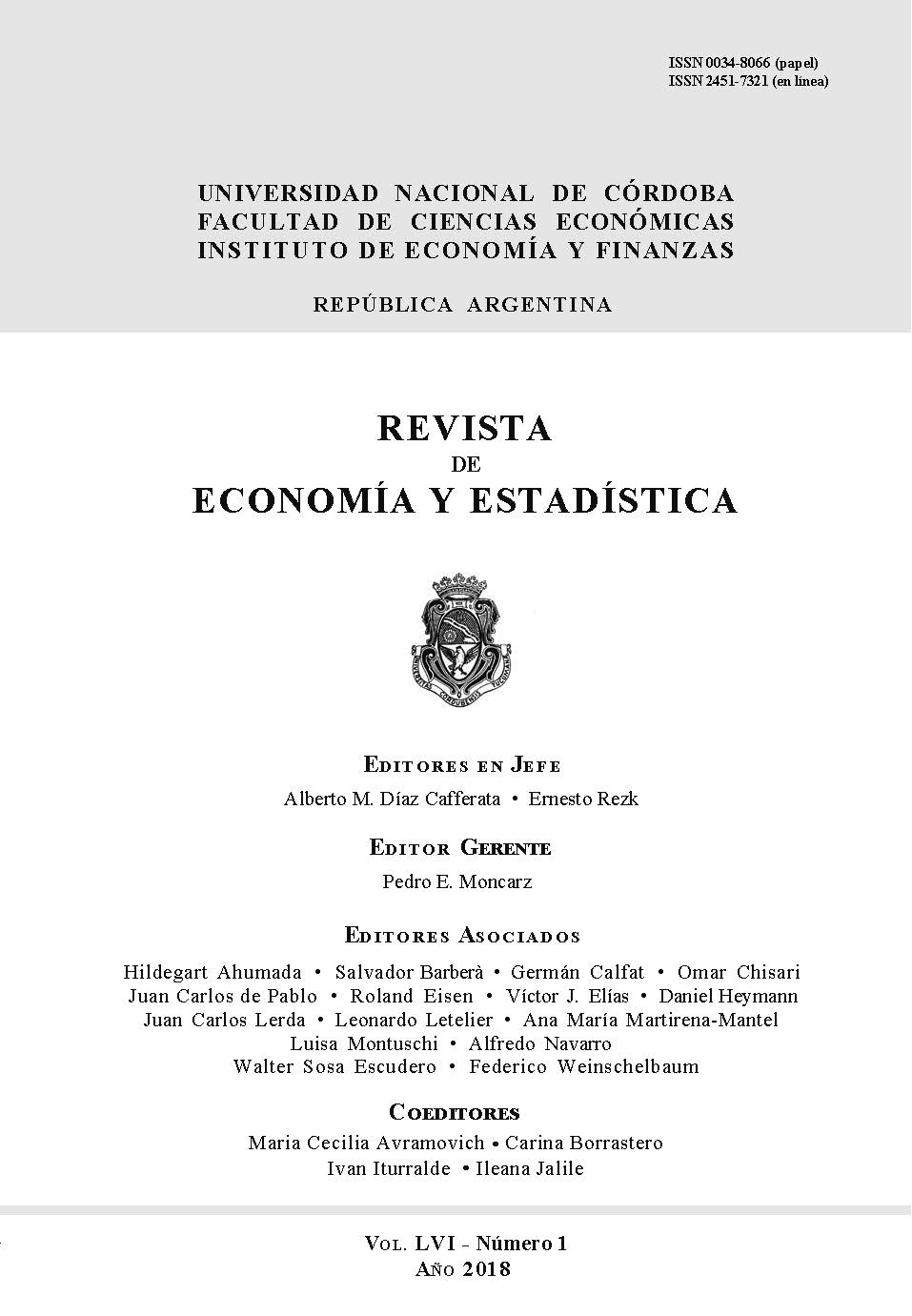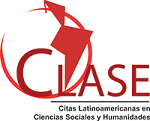Agrupación robusta de Bancos en Argentina
DOI:
https://doi.org/10.55444/2451.7321.2018.v56.n1.29385Palabras clave:
agrupación robusta, búsqueda de proyecciones, componentes principales comunes, K-media robusta, medidas de influencia, teoría de la empresaResumen
El propósito de este documento es clasificar y caracterizar 64 bancos, activos en 2010 en la Argentina, mediante técnicas robustas utilizadas con información para el período 2001-2010. En base a los criterios de estrategia establecidos en (Wang 2007) y (Werbin 2010), se seleccionaron siete variables. De acuerdo con la teoría bancaria, se obtuvieron cuatro conglomerados "naturales", denominados "Personal", "Comercial", "Típico" y "Otros bancos". Para comprender este agrupamiento, se utilizó el todo el conjunto de banco y se realizó un análisis de los componentes principales basado en la proyección, que mostró que esencialmente tres variables pueden atribuirse a la formación de diferentes agrupaciones. A fin de revelar la estructura interna de cada grupo, utilizamos el paquete R mclust para ajustar una mezcla gaussiana finita a los datos. Esto reveló aproximadamente una estructura de componentes similar, lo que garantiza un análisis de componentes principales comunes como en (Boente y Rodrigues, 2002). Esto nos permitió identificar tres variables que son suficientes para agrupar y caracterizar cada cluster. Las medidas de influencia de Boente se utilizaron para detectar casos extremos en el análisis de componentes principales comunes.
Descargas
Referencias
Boente, G., and L. Orellana (2001). “A robust approach to common principal components”. Statistics in Genetics and in the Environmental Sciences. Ed. by Birkhauser Basel et al., pp. 117–147.
Boente, G., A. M. Pires, and I. M.. Rodrigues (2002). “Influence functions and outlier detection under the common principal components model: A robust approach”. Biometrika 89.4, pp. 861–875.
Boente, G., A. M. Pires, and I. M. Rodrigues (2010). “Detecting influential observations in principal components and common principal components”. Computational Statistics and Data Analysis 54, pp. 2967–2975.
Chen, Edwin (2010). R Implementation of gap-statistics. [Retrieved from https://github.com/echen/gap-statistic/blob/master/gap-statistic.R].
Croux, C. personal website. [Retrieved from http://www.econ.kuleuven.be/public/NDBAE06/programs/#pca].
Croux, C., P. Filzmoser, and M. R. Oliveira (2005). “Algorithms for projection-pursuit robust principal component analysis”. Department of Decision Sciences an Information Management (KBI) KBI 0624.
Croux, C., and A. Ruiz-Gazen (1996). “A fast algorithm for robust principal components based on projection pursuit”. Compstat: Proceedings in Computational Statistics. Ed. by A. Prat. Physica-Verlag, Heidelberg, pp. 211-217.
Croux, C., and A. Ruiz-Gazen(2005). “High breakdown estimators for principal components: The projection-pursuit approach revisited”. Journal of Multivariate Analysis 95, pp. 206–226.
Ding, Chris, and Xiaofeng He (2004). “K-means clustering via principal component analysis”. Proceedings of the 21 St International Conference on Machine Learning. Canada, 2004: Banff.
Ercan, H and S. Sayaseng (2016). “The cluster analysis of the banking sector in Europe”. Economics and Management of Global Value Chains, pp. 111–127.
Farnè, M. and A. Vouldis (2017). “Business models of the banks in the euro area”. Working Paper Series European Central Bank 2070.
Filzmoser, P. et al. (2012). Package “pcaPP”.Peter Filzmoser, Heinrich Fritz and Klaudius Kalcher. [Retrieved from http://www.statistik.tuwien.ac.at/public/filz/]
Flury, B. K. (1984). “Common principal components in K Groups”.J. Amer. Statist. Assoc. 79, pp. 892–898.
Flury, B. K. (1988). Common principal components and related multivariate models, Wiley, New York.
Fraley, C., and A. Raftery (2007). “Model-based methods of classification: Using mclust software in chemometrics”. Journal of Statistical Software 18.6. [Retrieved from: http://www.jstatsoft.org/].
Fraley, C., A. Raftery, and Scrucca L. R package mclust Mantainer Luca Scrucca luca@stat.unipg.it.
Gordaliza, A. (1991a). “Best approximations to random variables based on trimming procedures”. Journal of Approximation Theory 64.2, pp. 162–180.
Gordaliza, A. (1991b). “On the breakdown point of multivariate location estimators based on trimming procedures”. Statistics & Probability Letters 11.5, pp. 387–394.
Hartigan, J. A. (1975). Clustering Algorithms. Inc: John Wiley & Sons.
Hennig, C. R Package fpc. c.hennig@ucl.ac.uk ucakche/ [Retrieved from http://www.homepages.ucl.ac.uk/].
Kassani, S.H., P. H. Kassani, and S. E. Najafi (2015). “Introducing a hybrid model of DEA and data mining in evaluating efficiency. Case study: Bank Branches”. Academic Journal of Research in Economics and Management 3.2, pp. 72–80.
Kondo, Y. (2011). “Robustification of the sparse K-means clustering algorithm”. University of British Columbia.
Kondo, Yumi, Matias Salibian-Barrera, and Ruben Zamar (2016). “RSKC: An R package for a robust and sparse K-means clustering algorithm”. Journal of Statistical Software 72.5, pp. 1–26. [Retrieved from https://doi.org/10.18637/jss.v072.i05].
Li, G., and Z. Chen (1985). “Projection-pursuit approach to robust dispersion matrices and principal components: Primary theory and Monte Carlo”. Journal of the American Statistical Association 80.391, pp. 759–766.
Lloyd, S. P. (1982). “Least squares quantization in PCM”. IEEE Transactions on Information Theory 28.2, pp. 129–136.
Sørensen, C. K. and J. M. Puigvert Gutiérrez (2006). “Euro area banking sector integration using hierarchical cluster analysis techniques”. Working Paper Series EuropeanCentral Bank 627.
Tibshirani, R., G. Whalter, and T. Hastie (2001). “Estimating the number of clusters in a data set via the gap statistic”. Journal of the Royal Statistical Society: Series B (Statistical Methodology) 63 Part 2, pp. 411–423.
Wang, D. (2007). “Three Essays on Bank Technology, cost Structure, and Performance”. PhD Dissertation. State University of New York at Binghamton.
Werbin, Eliana (2010). “Los determinantes de la rentabilidad de los bancos en Argentina (2005 – 2007)”. PhD thesis, Universidad Nacional de Córdoba.
Witten, D. M., and R. A Tibshirani (2010). “Framework for feature selection in clustering”. Journal of the American Statistical Association 105.490, pp. 713–726.
Descargas
Publicado
Número
Sección
Licencia
Derechos de autor 2018 José M. Vargas, Margarita Díaz, Fernando García

Esta obra está bajo una licencia internacional Creative Commons Atribución-NoComercial-SinDerivadas 4.0.
Aquellos autores/as que tengan publicaciones con esta revista, aceptan los términos siguientes:
Los autores/as conservarán sus derechos de autor y garantizarán a la revista el derecho de primera publicación de su obra, el cuál estará simultáneamente sujeto a la Licencia Creative Commons Atribución-NoComercial-SinDerivar 4.0 Internacional que permite a terceros compartir la obra siempre que se indique su autor y su primera publicación esta revista.
Los autores/as podrán adoptar otros acuerdos de licencia no exclusiva de distribución de la versión de la obra publicada (p. ej.: depositarla en un archivo telemático institucional o publicarla en un volumen monográfico) siempre que se indique la publicación inicial en esta revista.
Se permite y recomienda a los autores/as difundir su obra a través de Internet (p. ej.: en archivos telemáticos institucionales o en su página web) antes y durante el proceso de envío, lo cual puede producir intercambios interesantes y aumentar las citas de la obra publicada. (Véase El efecto del acceso abierto)














